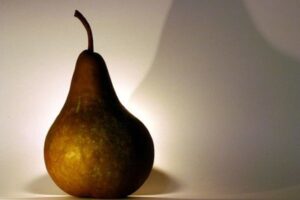Pears

Contents:
Season for Pears
Pears Described
How to Buy and Store Pears
How to Cook Pears
Health Benefits of Pears
Why Buy Natural and Organic Pears
Season for Pears August – October
Pears Described
Although none of use would like to be described as “pear-shaped,” hardly a soul who’s experienced a ripe, organic pear would wince at its sumptuousness. Pear varieties number in the thousands, but you will commonly encounter only 6 or 7 on your american pear hunt. Bartletts are the most ubiquitous and earliest arrivals, showing up in late July as a perfect summer segue fruit into fall. Hailing from the rose family, pears are generally juicy and sweet with a soft yet mildly grainy texture. They can have white to cream colored flesh and paper-thin skins that are yellow, brown, green, red or a combo of these colors.
How to Buy and Store Pears
When selecting your pears, go for those that are fragrant and without any blemishes or soft spots, though browning or “russeting” is perfectly fine. Unlike most fruits, pears are picked when they are mature but not ripe. Meaning, buying rock hard specimens isn’t a bad thing. Ripening your pears at home is a good way to go. To do so, place your pears in a paper bag and leave them at room temperature; to speed things up, place an apple or banana among them. When your fruit exudes a sweet aroma and the portion nearest to the stem gives to some gentle pressure, your pears are ripe. Now, you can refrigerate them until you’re ready to use, which is hopefully within a few days. Keep in mind: Pears will not ripen properly in the refrigerator.
How to Cook Pears
Pears make the perfect raw treat, washed and eaten with the peels intact to garner the most health benefits. But this fruit proves to be very versatile in the kitchen too. When cooking, you may want to remove the skins as they tend to toughen with heat. But because the flesh will turn brown quickly, you should squeeze some lemon juice over the top after peeling. Pears can be baked, poached, sautéed, roasted and grilled to delicious effect. They can also be showcased in baked goods, made into preserves, jams and chutneys. Think about it like this: If you can do it with an apple, you can do it with a pear, and then some.
Instead of chucking your overripe pears, consider using them in a smoothie, sauce or baked good, or even as a tasty thickening agent for soups or stews.
Health Benefits of Pears
Pears were once called the “gift of the gods,” probably owing to their incredible juicy sweetness. But along with their godly nature, pears are also an excellent source of dietary fiber and a good source of vitamin C and copper. Fiber is integral in not only keeping everything flowing through our systems, but it binds to cancer-causing and cholesterol-raising agents and delivers them out of our bodies, helping to keep us healthy for years to come. Vitamin C is also an antioxidant that is vital to our health and the functioning of our immune systems.
Why Buy Natural and Organic Pears
Pears in a can are a far cry from their fresh, firm, juicy and poignant brothers. Not only does eating food from a can put you at risk owing to the chemical BPA found in can linings, but it takes what was once quality and turns it into pedestrian fare. Plus, most canned products won’t be organic, adding pesticide residues to that con list. Choosing organically-grown fresh pears will be your best bet in many, many ways.
image: S Baker

